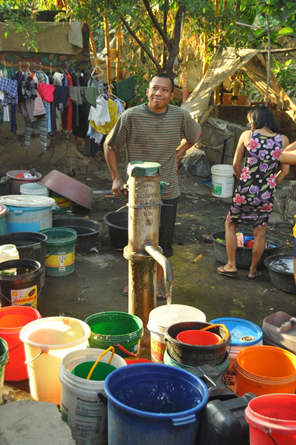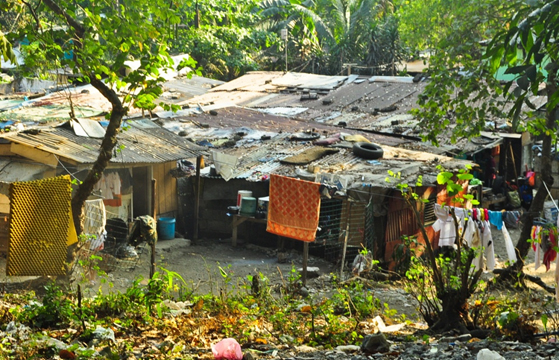
By ANTONIO JOSE GALAURAN and LUIS ADRIAN HIDALGO
(Conclusion)
IN May 2013, a few months after the University of the Philippines-Diliman signed an agreement with the agriculture and environment departments and the UP Beta Sigma Fraternity to develop its 22-hectare arboretum into a National Botanical Garden, residents of Pook Arboretum barricaded a portion of Metro Manila’s last remaining forest and installed placards and tarpaulins slamming the plan.
Two months later, they marched from their homes to the UP Diliman campus to force university officials to consult them on the proposal.
The 2,500 inhabitants of Pook Arboretum, all of them informal settlers, feared losing their homes once the botanical garden is established.
A series of dialogues between representatives from the university and Pook Arboretum would end in a compromise.
Affected residents were promised on-site relocation, participative maintenance, and livelihood projects. They were told that they would be consulted at different stages of the project through the Office of Community Relations (OCR) and the barangay.
And, the university assured them, the land would be used strictly for academic, and not commercial purposes.
To preserve and protect the UP Arboretum, it really would have been easier to just relocate the informal settlers. Removing them would mean removing human activities that disturb its ecosystem, agriculture and environment experts say.
“(But) throughout UP’s history, no community has been displaced. They are moved, but within the area,” said Prof. Melania L. Flores, who was then Vice Chancellor for Community Affairs when she met with protesting Pook Arboretum residents. “That’s the character of UP. Upholding human rights ranks high at the university.”
Under the on-site relocation scheme promised to arboretum residents, all families whose homes will be affected by the botanical garden project will be resettled in another area within the arboretum.
National Housing Authority community relations specialist Melinda Iballa said, however, the more appropriate term to describe the scheme UP has in mind is “near-site,” not on-site relocation.
“On-site is when you develop the nearby roads, for instance, but do not demolish the existing homes,” she said.
As owner of the arboretum, UP has the prerogative to sell land titles to the informal settlers in case of relocation, Iballa said.
She said the university can partner with the NHA to create housing programs for the settlers and can also tap government programs such as the Community Mortgage Program which finances creation of community homes.
Prof. Danilo Silvestre, head of the Technical Working Group and Oversight Committee for the botanical garden development project, said, however, he does not agree with on-site relocation for the informal settlers.
“That’s illegal. We cannot allocate that land to non-UP personnel,” he said.
Should the university pursue near-site relocation, Jose Manguera, chief of DA’s Soil Conservation Management Division, suggested that the community be moved to the westernmost side of the land near Central Avenue.
This way, it would be easier to cordon off the area and keep the community away from the arboretum, thus minimizing human activity in the forest, he said.
The vacated spaces can then be reclaimed and integrated into the plan for the proposed botanical garden.
DENR arborist Saturnino Danganan Jr. also said eliminating or reducing exotic tree species would eventually be necessary to give way to the planting of endemic species. As the name “National Botanical Garden” suggests, trees native to the country are needed, he said.
The safety of residents should also be considered when choosing the relocation area, he said.

Danganan recommends transferring families living around and on waterways to higher ground. Not only will it spare residents from flooding, but it will also help preserve the forest’s water system, he said.
“Water availability is very critical if we are talking about the National Botanical Garden,” he said.
Now that that DENR has completed the first phase of its tree inventory and the DA topographic and land use maps, the two agencies have been asked by UP officials to come up with livelihood programs that would help the arboretum residents become self-sufficient.
Data from the OCR show that residents generally earn low wages, with majority taking home P6,000 or less a month. Many are construction workers, department store attendants, vendors, laundry maids or scavengers. Children barely finish high school.
Danganan said the DENR can set up forest nurseries as a source of livelihood for the community. “(We) also hope to introduce production of seedlings,” he said.
DENR’s forestry rules and regulations require that every tree cut should be replaced. So there will always be a market for seedlings, Danganan said.
DA’s Manguera said the Bureau of Soils and Water Management can provide livelihood training such as compost making, mushroom production and mushroom culture.
The bureau can also provide the community with a shredder, which residents can use to shred litter and farm waste to produce compost, a component of organic fertilizer, he said.
And the DA can assist the community in developing farming schemes by providing vegetable seeds. But the soil needs to be rejuvenated first. It would take a year or two to make the soil productive again.
“To rejuvenate the soil, you have to apply several ameliorations, say, organic fertilizer, proper irrigation, and then you will have to toil the area,” Manguera said. “There is no bad soil as long as you’re a good farmer.”
(This report is based on the authors’ undergraduate thesis done last year for their journalism degree at the University of the Philippines-Diliman under the supervision of VERA Files trustee Yvonne T. Chua. The thesis placed second in the 2014 Philippine Journalism Research Conference.)
